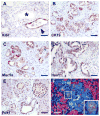Acute pancreatitis markedly accelerates pancreatic cancer progression in mice expressing oncogenic Kras
- PMID: 19292977
- PMCID: PMC2927854
- DOI: 10.1016/j.bbrc.2009.03.068
Acute pancreatitis markedly accelerates pancreatic cancer progression in mice expressing oncogenic Kras
Abstract
Chronic pancreatitis increases by 16-fold the risk of developing pancreatic ductal adenocarcinoma (PDAC), one of the deadliest human cancers. It also appears to accelerate cancer progression in genetically engineered mouse models. We now report that in a mouse model where oncogenic Kras is activated in all pancreatic cell types, two brief episodes of acute pancreatitis caused rapid PanIN progression and accelerated pancreatic cancer development. Thus, a brief inflammatory insult to the pancreas, when occurring in the context of oncogenic Kras(G12D), can initiate a cascade of events that dramatically enhances the risk for pancreatic malignant transformation.
Figures



References
-
- Warshaw AL, Fernandez-del Castillo C. Pancreatic carcinoma. N Engl J Med. 1992;326:455–65. - PubMed
-
- Hruban RH, Wilentz RE, Maitra A. Identification and analysis of precursors to invasive pancreatic cancer. Methods Mol Med. 2005;103:1–13. - PubMed
-
- Tuveson DA, Hingorani SR. Ductal pancreatic cancer in humans and mice. Cold Spring Harb Symp Quant Biol. 2005;70:65–72. - PubMed
-
- Hingorani SR, Petricoin EF, Maitra A, Rajapakse V, King C, Jacobetz MA, Ross S, Conrads TP, Veenstra TD, Hitt BA, Kawaguchi Y, Johann D, Liotta LA, Crawford HC, Putt ME, Jacks T, Wright CV, Hruban RH, Lowy AM, Tuveson DA. Preinvasive and invasive ductal pancreatic cancer and its early detection in the mouse. Cancer Cell. 2003;4:437–50. - PubMed
-
- Guerra C, Schuhmacher AJ, Canamero M, Grippo PJ, Verdaguer L, Perez-Gallego L, Dubus P, Sandgren EP, Barbacid M. Chronic pancreatitis is essential for induction of pancreatic ductal adenocarcinoma by K-Ras oncogenes in adult mice. Cancer Cell. 2007;11:291–302. - PubMed
Publication types
MeSH terms
Substances
Grants and funding
LinkOut - more resources
Full Text Sources
Other Literature Sources
Medical
Molecular Biology Databases
Miscellaneous

